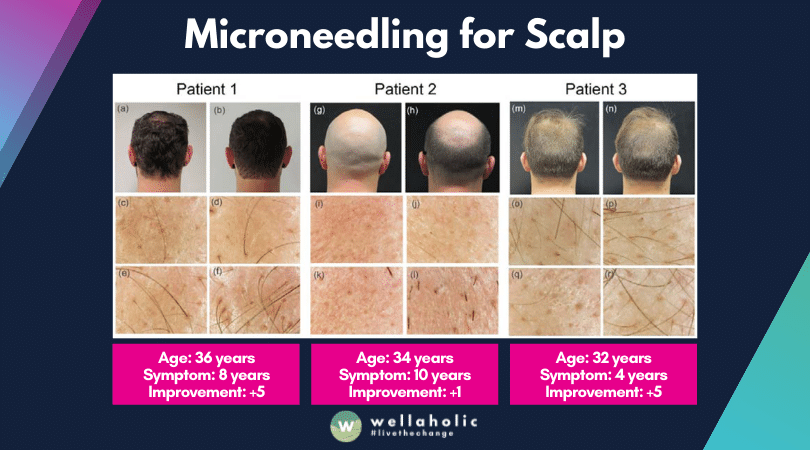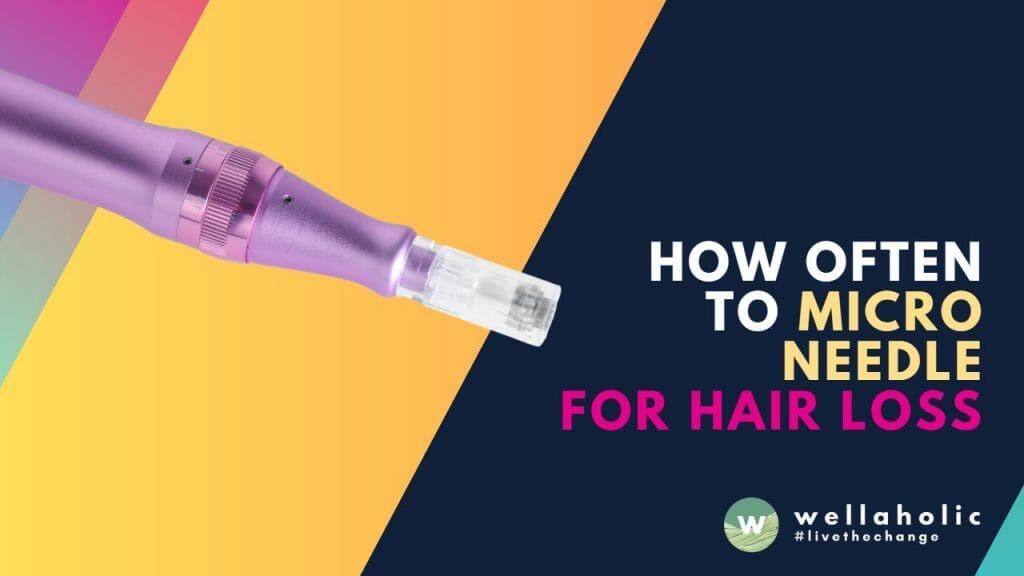
The Secret to Thicker, Healthier Hair: How Often to Microneedle for Hair Loss
Direct Answer: How Does Microneedling Boost Hair Growth Safely?
Microneedling stimulates hair growth by creating controlled micro-injuries on the scalp 🔬, which triggers the body’s natural healing response and activates dormant hair follicles 💪. This process boosts blood circulation and promotes collagen production to strengthen hair follicles, leading to thicker, healthier hair over time. Professional microneedling is crucial for safety and effectiveness, as it ensures sterile equipment and precise penetration depth for optimal results. Wellaholic’s data shows a 95% satisfaction rate for in-clinic treatments ✅, contrasting with about 30% of DIY cases requiring medical intervention due to complications like infection or scarring 🚨. Experts like Serene Chiam, Aesthetic Director at Wellaholic, emphasize professional care to avoid harm and maximize benefits.
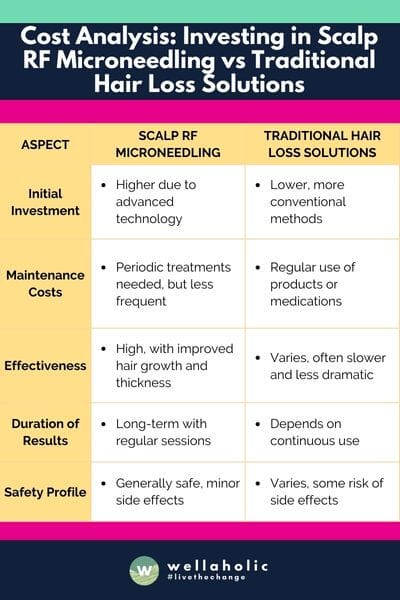
Introduction
Have you ever wondered why some people seem to have naturally thick, luscious hair while others struggle with thinning locks?
As aesthetic professionals with years of experience, we’ve seen countless customers at Wellaholic searching for solutions to hair loss. Through our work, we’ve discovered that microneedling can be a game-changer for many people dealing with this issue. But the question we often hear is: how often should you microneedle for the best results?
In this article, we’ll share our insights on the optimal frequency for microneedling treatments to promote hair growth. We’ll draw from our experiences at Wellaholic and Laser Clinics Australia to give you practical advice on how to use this technique effectively. We’ll also explore why consistency is key when it comes to seeing real improvements in hair thickness and health.
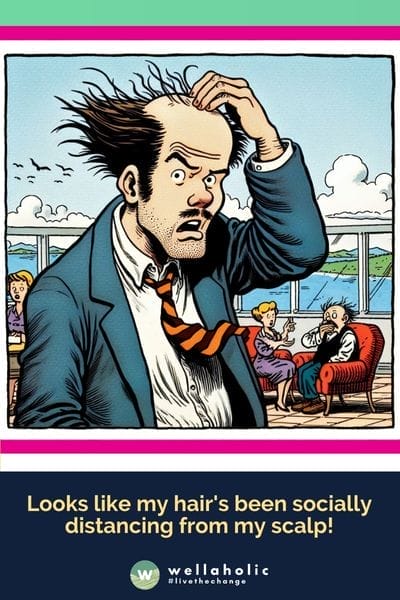
How Often Should You Do Microneedling for Hair Loss?
The frequency of scalp microneedling sessions for hair loss can be broken down into the following stages:
- Initial Phase: For those starting out, I usually recommend a series of sessions spaced about four to six weeks apart. This initial phase is crucial for stimulating the scalp and promoting hair growth.
- Maintenance Phase: After the initial series, it’s generally advisable to shift to a maintenance phase. This might mean having microneedling sessions every 1 to 3 months, depending on individual response and goals.
- Personalization is Key: It’s important to remember that each individual’s response can vary. Hair loss, skin type, and overall health determine how frequently microneedling should be done.
- Professional Guidance: Always seek advice from a qualified professional. Regular assessments can help tailor the treatment frequency to your specific needs, ensuring safety and effectiveness.
“Rejuvenate your hair with microneedling – a little every day goes a long way!
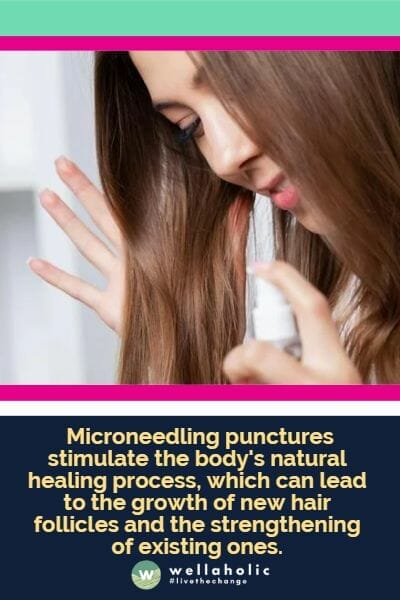
Microneedling the Scalp Once Every 1 to 3 Weeks
Unlock the secret to hair regrowth with microneedling, as supported by compelling evidence. Studies have confirmed that undergoing microneedling sessions every 1–3 weeks can promote hair regrowth. These intervals have been specifically tested in individuals with androgenic alopecia (AGA), a common form of hair loss.
A Case Study: Unveiling the Results
Delve into a comprehensive case study conducted at the Department of Dermatology, Lokmanya Tilak Municipal Medical College and Hospital in Mumbai. This 12-week study involved 100 men with AGA who willingly participated and provided informed consent.
Participants were randomly split into two groups using the “tossing coin” method: the Microneedling group (N = 50) and the Minoxidil group (N = 50). To ensure consistent hair shaft length at baseline, all patients had their scalp shaved prior to treatment.
The Microneedling Journey: A Weekly Procedure
Within the Microneedling group, patients underwent a weekly procedure on the scalp. This involved microneedling sessions complemented by the application of 1 ml of 5% Minoxidil lotion, applied twice daily. On the other hand, the Minoxidil group solely applied 1 ml of 5% Minoxidil lotion twice daily.
Unveiling the Results: Microneedling Outperforms Minoxidil
At the end of the 12-week study, the results were nothing short of remarkable. Microneedling group had a significantly greater increase in hair count at week 12 than the Minoxidil group. These findings highlight the efficacy of microneedling as a promising treatment for hair regrowth in individuals with androgenic alopecia.
The mean change in hair count at week 12 was significantly greater for the Microneedling group compared to the Minoxidil group.
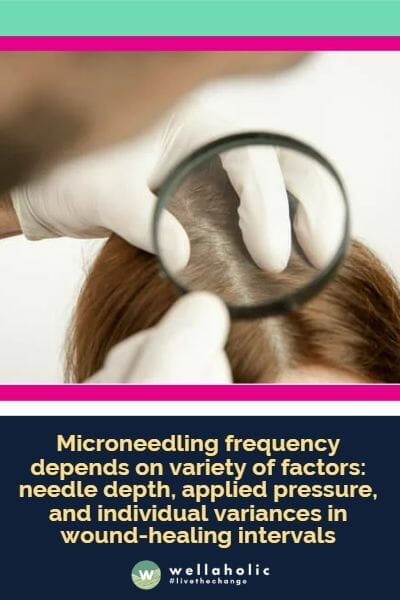
Microneedling Frequency Depends on Variety of Factors
In my experience in aesthetics, I’ve seen how microneedling can rejuvenate the skin. However, it’s important to know that the frequency of treatments depends on several factors. It’s not a one-size-fits-all approach. Here’s what I’ve learned:
- Skin Type and Condition: Those with sensitive skin or certain skin conditions might need longer intervals between sessions. It’s all about how your skin heals and responds.
- Treatment Goals: Are you targeting fine lines, acne scars, or just general skin rejuvenation? Each goal may require different treatment frequencies.
- Intensity of Treatment: Deeper microneedling sessions, which can address more significant skin issues, often necessitate longer recovery times, meaning fewer treatments in a year.
- Individual Healing Process: Everyone’s skin heals differently. Some might be ready for another session after a few weeks, while others may need more time.
Remember, it’s about finding a balance that works for your skin while achieving desired results. Always consult with a skincare professional to tailor the treatment to your unique needs.
Table: Recommended Frequency of Microneedling for Different Types of Hair Loss
See the table below for the recommended frequency of microneedling for different types of hair loss
| Type of Hair Loss | Frequency of Microneedling |
|---|---|
| Mild hair loss | Once every 2-4 weeks |
| Moderate hair loss | Once a week or every other week |
| Severe hair loss | Once a week or every other week, for several months |
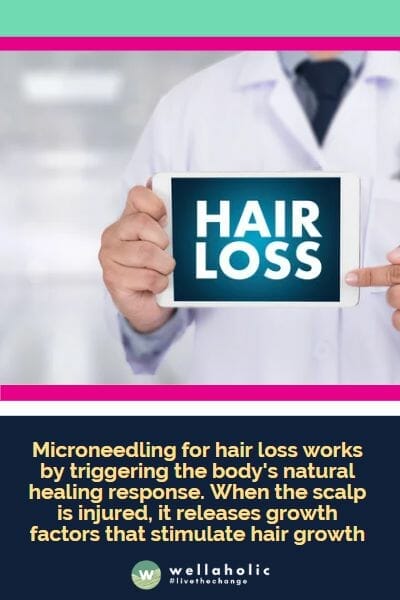
How Does Microneedling for Hair Loss Work?
rom conversations with industry experts and through my own research, I’ve gained insights into how this technique can be a game-changer for those battling hair loss. Microneedling, a procedure known for its skin rejuvenation benefits, also extends its magic to hair restoration:
- Stimulation of Scalp Healing: The process involves using fine needles to create micro-injuries on the scalp. This controlled injury triggers the body’s natural healing process, stimulating blood flow and nutrient supply to the hair follicles.
- Enhancement of Product Absorption: These micro-injuries increase the absorption of topical hair growth serums or medications, enhancing their efficacy.
- Activation of Stem Cells: The treatment activates stem cells in the hair follicles, potentially leading to hair regrowth and thickening.
- Collagen and Elastin Production: It improves hair density and promotes collagen and elastin production for a healthier scalp.
Although promising, it is important to note that this treatment should be done by trained professionals and that results may vary.
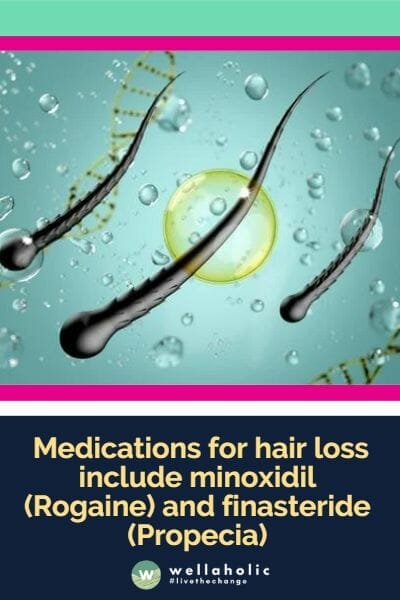
Microneedling Findings
A quick glance at these results suggests two things:
- Microneedling enhances minoxidil’s effectiveness. Two studies have found that microneedling can significantly enhance the effectiveness of minoxidil as a treatment. Combining these two treatments produces better results compared to using microneedling or minoxidil alone.
- Microneedling once weekly can be better than biweekly. Bao et al. (3) showed that microneedling once every fortnight resulted in an exceedingly 25% increase in hair count. Dhurat et al. (4) showed that microneedling once per week resulted in an exceedingly 40% increase in hair count. Both studies used a 1.5 mm needle length; both studies used 5% topical minoxidil twice-daily alongside microneedling.
- We can’t compare hair change percentages between two studies because there are many factors that could affect the results, such as different demographics, study duration, and investigators. But if we take this back-of-the-envelope comparison at face-value, we’re faced with a stimulating takeaway.
Feedback from Users
This user (with hair thinning) utilised a 2.0 mm dermapen weekly alongside 5% minoxidil for his first 2 months. After 2 months, he moved to 10-14 day wounding intervals. He does not use minoxidil on the days that he does microneedling.
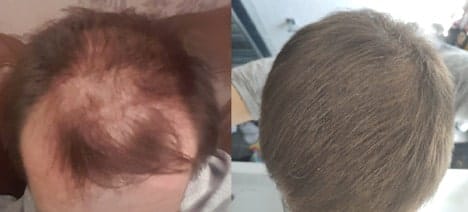
This user employed weekly microneedling with a 1.5 mm dermaroller alongside topical minoxidil (percentage not specific). After 1.5 months, he transitioned to microneedling only with these results after 3 months (Note: left photo is +3 months; right photo is +0 months).
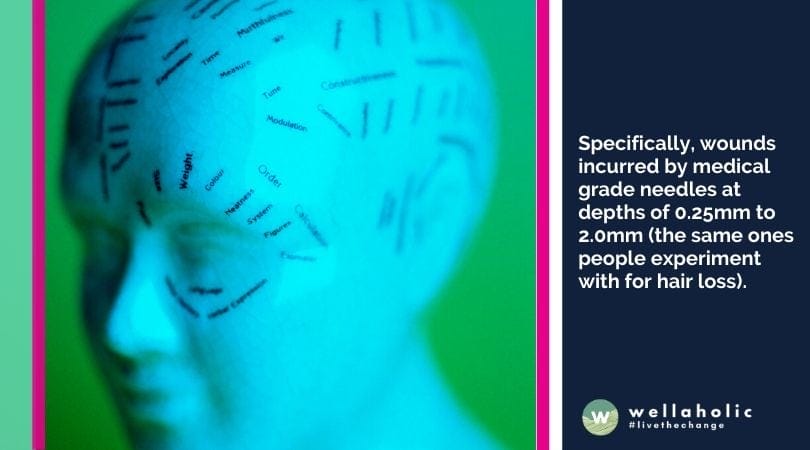
Microneedling frequencies: what you need to consider
More microneedling or deeper needle penetration can cause scarring and a higher cancer risk.
Recovery time
Wound healing windows depend entirely on the character of an injury. Microneedling can affect healing time based on factors like pressure, number of needles, procedure duration, and needle depth.
The goal: to wound deep enough / often enough to evoke follicle proliferation – but not deep enough / often enough to cause scarring.
So, what does the evidence say about average healing times for wounds this deep? Medical grade needles can cause wounds at depths of 0.25 mm to 2.0 mm, which are the same ones used for hair loss treatment.
The short-answer: we don’t yet know. After microneedling, we haven’t fully studied the three stages of wound-healing in human skin: inflammation, proliferation, and maturation.
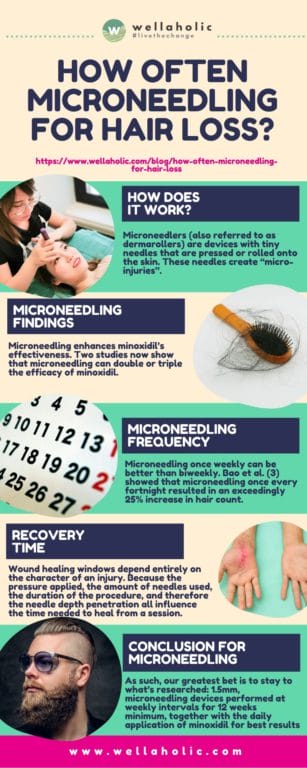
Stage 1: Inflammation of the scalp area
According to Dunkin et al. (5), cuts on the skin that are 0.5-0.6 mm deep may cause inflammation for 24–48 hours. However, these cuts will heal completely without leaving any scars.
Some researchers have said that using longer medical grade needles (1.5 mm to 2.00 mm) less often (i.e., once every 1–2 weeks) should not cause scarring.
Many of us prefer to use a 0.5 mm needling device daily, while clinical trials on microneedling have used 1.5 mm to 2.0 mm rollers less frequently (every 1-2 weeks).
Stage 2: Proliferation and Healing of Wounds
After the initial inflammatory response, the subsequent stage of wound-healing is proliferation. When a wound heals, new tissues such as extracellular matrix and collagen are formed. These new tissues provide the foundation for the growth of new blood vessels, known as angiogenesis, in the scalp.
The proliferation phase starts immediately after microneedling and should reach its peak after 2 months. Nowadays, it’s not known how epidermal and dermal stem cells are laid low with microneedling.
Stage 3: Remodelling and Maturation
New type III collagen fibres integrate into the present skin matrix with no trace of fibrotic tissue. Collagen is formed from a depth of 0.6 mm and moves towards the basal membrane when using 1.5 mm needles. This is a motivating fact.(8)
Wounds heal within 4–6 weeks. But, the wounding initiated by microneedling may be a (for the foremost part) controlled micro-injury. As such, these wounds take significantly less time to heal.
That said, it’s hard to specify a general healing window for a given microneedling session. This can happen due to several factors that influence the extent of the injury and the necessary time for complete recovery.
These factors are centred around depth of penetration of the needle and individual variances in healing time. The deeper the needle and the more pressure used in microneedling, the longer the healing time required. This is also influenced by how long your body takes to heal the treated area.
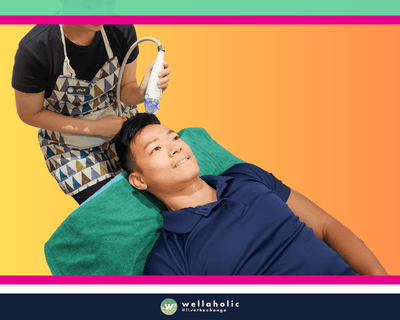
How Often Should You Do Microneedling for Hair Loss?
The frequency of microneedling for hair loss varies based on factors like the severity of hair loss, the needle size, and how well the individual heals.
As a general rule, most people can expect to see positive results from microneedling within three to six months. To maintain these results, it’s recommended to repeat the treatment every four to six weeks.
The frequency of microneedling for hair loss varies for each person, so it’s important to consult a dermatologist for a personalized treatment plan.

Conclusion
In conclusion, based on my extensive interactions with customers experiencing hair loss and my ongoing research in aesthetic treatments, I’ve found that the frequency of microneedling sessions plays a crucial role in promoting thicker, healthier hair. Typically, for those beginning their microneedling journey, 1.5mm, microneedling devices performed at weekly intervals for 12 weeks minimum, together with the daily application of minoxidil for best results.
Microneedling for Healthy Hair Growth
This allows the scalp sufficient time to heal and respond to the treatment, encouraging natural hair growth. As progress is observed, sessions can be gradually spaced out to once a month, ensuring continuous stimulation of the hair follicles while maintaining scalp health. It’s important to remember that individual responses to microneedling can vary based on factors like age, lifestyle, and overall scalp condition.
Therefore, a personalized approach, preferably guided by a professional, is essential for optimal results. Consistency and patience are key – as the benefits of microneedling for hair loss are typically observed over a period of time, not overnight. Remember, the journey to thicker, healthier hair is a marathon, not a sprint.
Frequently Asked Questions (FAQ)
Q1: What are the potential side effects of microneedling for hair loss?
A: Based on the information provided in the search results, the most common potential side effects of microneedling for hair loss include bruising, oozing from the wounds, redness, swelling, and pain. These side effects are generally mild and should diminish within about 5 days after treatment. There is also a small risk of scarring and infection. People who are immunocompromised, pregnant, or have certain skin conditions may be at higher risk for adverse effects. It’s important not to ignore extreme pain or prolonged irritation, and to consult a professional if you experience concerning symptoms.
Q2: How often should you microneedle for hair?
A: At Wellaholic, I recommend microneedling your scalp once a week for the first month, then twice a week in the second month. After that, you can maintain your results by microneedling once every two weeks. The needle depth should be between 0.5mm to 1.5mm, depending on your scalp sensitivity and treatment goals. Always keep your microneedling device clean and disinfected, and avoid microneedling if you have any open wounds or active skin infections on your scalp. Consistency is key for optimal hair growth results.
Q3: Can microneedling regrow hair?
A: Yes, microneedling can help regrow hair. The tiny needles create micro-injuries on the scalp, triggering the body’s natural healing response. This increases blood flow, bringing more nutrients and oxygen to the hair follicles[]. Microneedling also stimulates the production of collagen and growth factors that promote hair growth. It can enhance the absorption and effectiveness of topical hair loss treatments like minoxidil. While individual results vary, many of my clients have seen thicker, healthier hair after a series of microneedling treatments at our clinic.
Q4: What is the best microneedling length for hair loss?
A: Based on the research I’ve reviewed, the optimal microneedling length for treating hair loss is between 0.5mm to 1.5mm. A 0.5mm needle length can help enhance absorption of topical hair growth products, while 1.0mm to 1.5mm lengths are better for stimulating the deeper layers of the scalp to promote hair growth. Studies show microneedling lengths in this range, done weekly at first and then monthly, can lead to significant increases in hair count and thickness, especially when combined with other treatments like minoxidil, PRP, or growth factor serums.
Q5: Why choose Wellaholic for microneedling hair loss treatments in Singapore?
A: At Wellaholic, we offer effective microneedling treatments for hair loss. Our treatments use advanced microneedling devices to stimulate hair follicles and promote hair regrowth. We combine this with 5% minoxidil for optimal results, as studies show microneedling plus minoxidil leads to significant hair growth over 12 weeks. Our prices are affordable, with each scalp microneedling session starting from around $100. We focus on customer service and have over 2000 positive reviews. Choose Wellaholic for science-backed treatments by experienced professionals at reasonable prices.
Q6: Are there any lifestyle or dietary recommendations to complement microneedling treatments?
A: Maintaining a healthy diet, reducing stress, and avoiding harsh hair treatments can complement microneedling. Wellaholic’s experts can provide personalized advice based on your lifestyle and hair condition.

Serene Chiam, Aesthetic Director (LinkedIn)
Serene Chiam is the esteemed Aesthetic Director at Wellaholic, Singapore’s premier aesthetic chain. With over a decade of experience in the aesthetics industry, including her previous role as a Clinical Aesthetics Manager at Laser Clinics Australia, Serene is a highly skilled and knowledgeable professional. She holds a CIDESCO certificate in skincare and a Bachelor of Health Science (Aesthetics) from Torrens University of Australia, which have equipped her with the expertise to provide cutting-edge treatments for sunspots, age spots, and other skin imperfections. Serene’s dedication to continuous learning and staying at the forefront of aesthetic technology ensures that Wellaholic’s clients receive the most effective and safe treatments for their skincare needs. Her passion for helping others achieve healthy, glowing skin has made her an invaluable asset to the Wellaholic team.
Contact Serene at serene@wellaholic.com
GET IN TOUCH
Book Now Pay Later

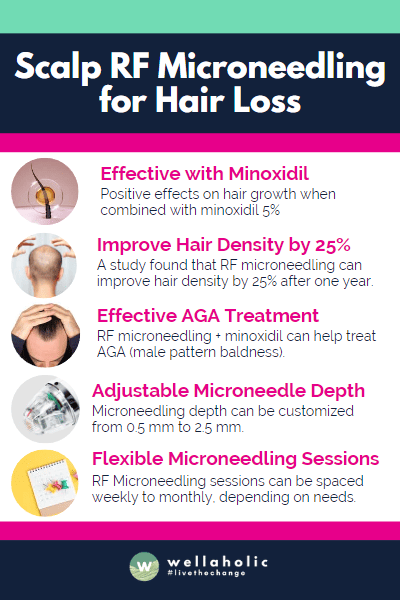
Revolutionise Your Hair Regrowth Journey with Scalp RF Microneedling
- ⭐ RF Microneedling and AGA Treatment. RF microneedling + minoxidil can help treat AGA (male pattern baldness).
- ⭐ Efficacy in Pattern Hair Loss. RF microneedling is effective for hair loss in both men and women.
- ⭐ Study Results on Hair Density Increase. A study found that RF microneedling can improve hair density by 25% after one year.
- ⭐ Adjustable Depth of Microneedling. Microneedling depth can be customized from 0.5 mm to 2.5 mm.
- ⭐ Flexible RF Microneedling Frequency. RF Microneedling sessions can be spaced from weekly to monthly, depending on your needs.
- ⭐ Award-Winning. Wellaholic’s treatments have been recognized by top beauty publications such as Daily Vanity, Beauty Insider, and Tropika Club Magazine.
- ⭐ Over 2000 Verified Customer Reviews. Wellaholic has over 30 industry awards and over 2000 positive reviews from customers, and >50% are repeat customers.
